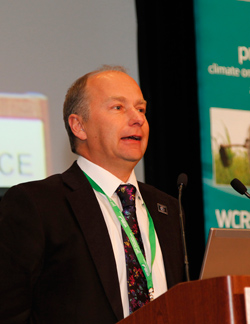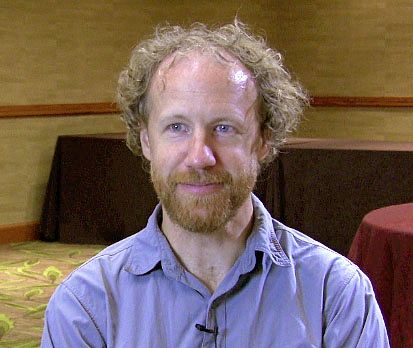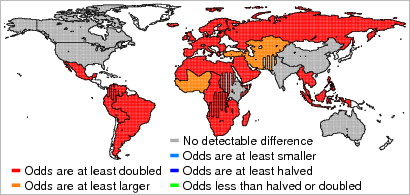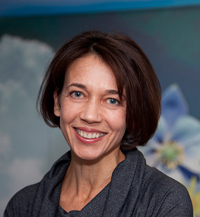Is this climate change?
Event attribution on demand: some promising methods
Feb 6, 2012 - by Staff
Feb 6, 2012 - by Staff
30 January 2012 • Although NOAA has been prohibited by Congress from establishing a national climate service, there’s interest among many scientists worldwide in providing a particular type of climate product: prompt analysis for a recent extreme weather event to estimate how much it was shaped by human influence.
 Peter Stott (UK Met Office Hadley Centre) addresses the World Climate Research Programme's Open Science Conference on October 27, 2011, in Denver, Colorado.
Peter Stott (UK Met Office Hadley Centre) addresses the World Climate Research Programme's Open Science Conference on October 27, 2011, in Denver, Colorado.
Peter Stott (UK Met Office Hadley Centre) laid out some ideas and a few cautions at the World Climate Research Program’s Open Science Conference, where he spoke (PDF) and presented a summary paper (PDF). (The meeting, held in October 2011 in Denver, was coordinated by UCAR’s Joint Office for Science Support.)
“It is clear that attribution forms a key part of any climate service, the essential bridge between monitoring and prediction services, that puts recent weather and climate conditions into a longer-term context and relates what has just happened to likely future [conditions],” said Stott. However, he added, “different groups of users are likely to have different requirements.”
Dáithí Stone prototyped an attribution-on-the-fly system at the University of Cape Town before moving to Lawrence Berkeley National Laboratory in late 2011. The Weather Risk Attribution Forecast is billed as “the world’s first real-time product to examine whether and how greenhouse gas emissions have contributed to our weather.” Visitors can find global and regional maps estimating how human influence has affected the odds that the current month will be unusually warm, cool, wet, or dry.
 Dáithí Stone (Lawrence Berkeley National Laboratory) pioneered the Weather Risk Attribution Forecast website.
Dáithí Stone (Lawrence Berkeley National Laboratory) pioneered the Weather Risk Attribution Forecast website.
“We’re experimenting with the platform and how you’d run it in some sort of operational service,” says Stone.
The Hadley Centre is exploring a more elaborate system along the same lines, according to Stott, while the University of Oxford is inviting members of the public to help out with event-attribution research through the weatherathome project. These and other activities are being coordinated by the Attribution of Climate-related Events (ACE) group, which has brought researchers from several organizations together for a number of meetings since 2010, with support from NOAA and the U.K.’s Foreign and Commonwealth Office.
There’s a parallel effort to enhance a broad range of attribution analyses, including those that don’t need to be done on short order. The International Detection and Attribution Group (IDAG), sponsored by the U.S. Department of Energy, has served as a vehicle for collaboration since the earliest days of attribution research.
 This outlook, issued on December 13, 2011, shows how human-produced greenhouse gases changed the odds that January 2012 would be as warm as the top five Januarys in the reference period 1960–2011. (Image courtesy Weather Risk Attribution Forecast.)
This outlook, issued on December 13, 2011, shows how human-produced greenhouse gases changed the odds that January 2012 would be as warm as the top five Januarys in the reference period 1960–2011. (Image courtesy Weather Risk Attribution Forecast.)
The group advises federal agencies as requested, publishes occasional review papers, and meets each winter at NCAR to share ideas. Claudia Tebaldi, a statistician who divides her time between NCAR and Climate Central, is in the midst of a three-year term as group lead. In contrast to the real-time attribution efforts, she notes, "IDAG is more about methodology."
During its 2012 meeting, held February 1–2 at NCAR, the group discussed preliminary results from ongoing studies of several extreme events, including the Texas heat wave and Thailand floods of 2011. A new topic was the question of how sea level rise to date may have increased the odds of high storm surges along the U.S. coasts.
 Claudia Tebaldi (NCAR) is chairing the International Detection and Attribution Group.
Claudia Tebaldi (NCAR) is chairing the International Detection and Attribution Group.
Whatever its pace, connecting the dots between an atmospheric extreme and greenhouse gases must be done carefully, as Stott emphasized in Denver. For example, the influence of climate change on the odds of a major flood in some parts of the world may be different during El Niño than during La Niña conditions.
Researchers also stress the importance of looking at how climate change may decrease the odds of some events. And some changes may compound each other. For example, many areas are now seeing their heaviest rains and snows becoming even heavier, with longer dry spells in between. Those changes in precipitation variability could, in turn, influence temperature variability in ways that aren’t fully fleshed out.
The experts say we are still some years away from being able to obtain reliable attribution assessments on the fly. “There remains at least a six-month lag between the occurrence of an event and the results of a detailed attribution analysis,” says Stone. But he adds that the ACE group is working on ways of making these analyses systematic, such that answers could be ready within days. As it turns out, the toughest challenge may be presenting the results in a way that’s easy for non-experts to comprehend (see Extreme weather forensics).